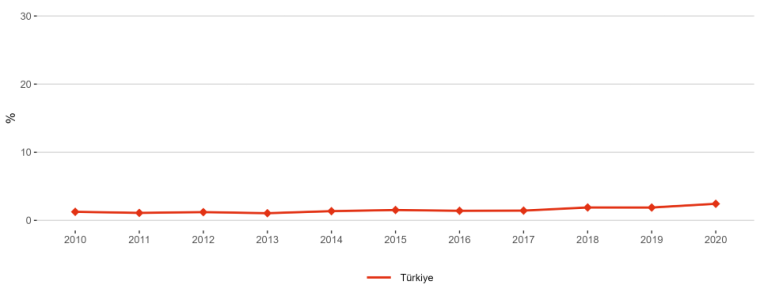ERA Country Report 2023
Türkiye
Edited by Serdar Türkeli (UNU MERIT)
as part of ‘Development of the ERA Scoreboard, the ERA Dashboard and the Regular Reports’ project for the European Commission, Directorate-General for Research and Innovation under Framework Contract N° 2018/RTD/A2/OP/PP-07001-2018 Lot 2 (EDAR)
Click here to download this country report![]()
- Table of contents
-
ERA Country Report 2023: Türkiye
1. National context
1.1. Overview of the ERA policy agenda implementation
1.2. Policy context
2. Assessment of the Implementation of the ERA Policy Agenda and ERA Priorities
2.1. ERA Priority 1: Deepening a truly functional internal market for knowledge
2.2. ERA Priority 2: Taking up together the challenges posed by the twin green and digital transition and increasing society’s participation in the ERA
2.3. ERA Priority 3: Amplifying access to research and innovation excellence across the Union
2.4. ERA Priority 4: Advancing concerted research and innovation investments and reforms
3. Country-specific drivers and barriers
4. Final remarks
5. Bibliography
6. Annexes
6.1. Annex 1: Graphs
ERA Country Report 2023: Türkiye
|
Key takeaways:
|
1. National context
1.1. Overview of the ERA policy agenda implementation
According to European Innovation Scoreboard, Türkiye is an Emerging Innovator with performance at 47.6% of the EU average, below the average of the Emerging Innovators. Its performance is increasing at a rate lower than that of the EU (8.5%-points) and hence its performance gap to the EU is becoming larger. However, Türkiye is committed to becoming an active partner in the European Research Area (ERA).
Türkiye has developed and implemented key policies promoting the ERA Policy Agenda 2022-2024. Already in 2019, Türkiye launched a Turkish National Roadmap on European Research Area to boost the national research and innovation capacity, and the cooperation with and alignment to the ERA.
The progress of Türkiye in several ERA Priorities (such as in e-infrastructures, open data and gender mainstreaming in research) and the aim of increasing national research and innovation capacity are recognised. The steady progress of Türkiye in Horizon 2020 is also deemed particularly successful in the European Research Council, in Marie Skłodowska-Curie Actions, and in Energy research. Türkiye’s commitment to science, technology, and innovation (STI) is evident in its participation in EU Framework Programmes and its active engagement in the activities of the European Research Area and Innovation Committee (ERAC). The country has also held high-level dialogue meetings with the EU to explore cooperation in areas such as the Green Deal and Industry 4.0.
The international agreement between the European Union and the Republic of Türkiye on the participation of Türkiye in Horizon Europe was published on 23 March 2022. This international agreement gathers the main objectives of the ERA in relation to Türkiye.
1.2. Policy context
Key actors in the governance of the national science, technology and innovation (STI), hence Research and Innovation (R&I) ecosystem in Türkiye are: the Science, Technology and Innovation Policies Council (STIPC), the Presidency of Strategy and Budget (SBB), the Ministries of Industry and Technology (MoIT), Treasury and Finance, and Trade, other sectoral and line ministries in the fields of agriculture, education, energy, environment, climate change, health, transportation, and affiliated agencies, the Council of Higher Education (CoHE), the Scientific and Technological Research Council of Türkiye (TÜBİTAK), the Small and Medium Industry Development Organisation (KOSGEB) and the Digital Transformation Office (DTO).
The coordination of research and innovation policies in Türkiye is overseen at the Presidential level through the STIPC. The Council formulates policies, recommends STI strategies, identifies strategic technology areas, and evaluates the national STI ecosystem. The Council aligns thematic STI, and R&I targets with national strategy documents and international partners.
Comprehensive policy initiatives have been introduced in Türkiye that are in line with advancing the national research and innovation capacity and capability, and the alignment of these capacities and capabilities towards a deeper cooperation within the ERA.^
The Eleventh Development Plan and the following Twelfth Development Plan (2024-2028 Vision 2053) serve as the strategic frameworks for STI hence research and innovation (R&I) policies in Türkiye. They emphasise the importance of knowledge production, research and development (R&D), research and innovation (R&I) ecosystems to enhance value-added production and support high-tech sectors. Priority areas include chemicals, pharmaceuticals, electronics, machinery, automotive, and rail systems. Critical technologies, such as AI, IoT, big data, and cybersecurity are also emphasised.
2. Assessment of the Implementation of the ERA Policy Agenda and ERA Priorities
This section provides an overview on the ERA Actions through the national initiatives that Türkiye has implemented, gathered from the OECD STIP Survey. In addition, it provides a quantitative analysis on the progress towards achieving the ERA Priorities through selected ERA indicators.
The quantitative information presents the most recent data available for the ERA Scoreboard and ERA Dashboard indicators. However, in some cases, the data available pre-dates the ERA Policy Agenda. Therefore, the longer-term trends covering the last ten years are presented. The indicators falling under each ERA priority are presented below, and the general indicators are outlined in Table 1. More detailed information on the data and graphs can be found in Annex 1. This report will serve as a baseline for reporting in the future.
|
Indicator |
Most Recent Metric |
|
Gross Domestic Expenditure on R&D (GERD) as a percentage of GDP |
1.09 (2020) |
|
Government Budget Allocations for R&D (GBARD) as a share of GDP |
0.28 (2021) |
|
Researchers (in full-time equivalent) per million inhabitants |
2,206.8 (2021) |
|
Business Enterprise expenditure on R&D (BERD) as a percentage of GDP |
0.7 (2020) |
Source: compiled by research team based on the ERA Scoreboard and EAR Dashboard indicators
2.1. ERA Priority 1: Deepening a truly functional internal market for knowledge
2.1.1. State of play in the implementation of the ERA Actions
Türkiye has not formally committed to any ERA action. Nonetheless, the country has developed many initiatives that are directly related to the ideas encouraged by the ERA actions.
In relation to the implementation of ERA Action 1: Enable the open sharing of knowledge and the re-use of research outputs, including through the development of the European Open Science Cloud (EOSC), the first international open access agreement of Türkiye was signed with Wiley Online Library. This is a three-year open access agreement with the Scientific and Technological Research Council of Türkiye (TÜBİTAK ULAKBİM) that started in January 2023.
Open access benefits from earlier committees, data and technical infrastructures, policies, and regulations. These developments were TÜBİTAK ULAKBIM National Open Science Committee (2015); Turkish Academic Archive (Harman) (2016); COHE Open Science and Open Access (2018) where CoHE established Türkiye Research Data and Open Data Task Force, and Open Science Policy released based on OpenAIRE model and sent to Turkish universities as a model policy by CoHE policy; National Data Dictionary (2019); Open Data Project (2019); TÜBİTAK Open Science Policy (2019) and Turkish Era Roadmap.
As regards ERA Action 3: Reform the Assessment System for research, researchers and institutions, the Entrepreneurial and Innovative University Index (EIUI) is a national policy initiative and a corresponding performance analysis of universities embodying their innovation and entrepreneurship activities based on an original composite index in Türkiye.
In relation to ERA Action 4: Promote attractive research careers, talent circulation and mobility, TÜBİTAK 2232-b International Fellowship for Early-Stage Researchers and TENMAK doctoral and postdoctoral researchers support are key programmes. The former offers financial assistance to individuals under 40 who are residing abroad, with the aim of facilitating their relocation to Türkiye and sustaining their activities in the country. The latter offers scholarship assistance to doctoral and postdoctoral researchers, aiming to fulfil the research and educational requirements of students and researchers, both domestically and internationally.
ERA Action 5: Promote gender equality and foster inclusiveness. TÜBİTAK 's Policy Principles for Increasing the Participation of Women Researchers creates the foundation for gender equality in Türkiye. To improve the inclusiveness of physically challenged students to higher education COHE - Affirmative Action for students with disabilities and CoHE- Barrier-Free University Awards are active strategies.
ERA Action 8: Strengthen sustainability, accessibility and resilience of research infrastructures in the ERA. Türkiye's Law No. 6550 (2014) aims to considerably boost the public research system. The law aims to ensure the efficient use and sustainability of research infrastructures, establish cooperation with the private sector and related public institutions, manage sustainable finance and employment, provide 24/7 accessibility to researchers, and monitor and evaluate the performance of research infrastructures.
Certified Research Infrastructures in Türkiye develop technologies in biomedicine and genomics, nanotechnology, micro/nanoelectromechanical systems (MEMS/NEMS), solar energy, accelerator technologies, and in the maritime sector. Recent additions include nanophotonics, astrophysics, and life sciences.
ERA Action 9 aims to promote a positive environment and level playing field for international cooperation based on reciprocity. 2216-B TÜBİTAK-TWAS Postgraduate and Postdoctoral Fellowship Programmes are key initiatives in place. These fellowships are enabled for international PhD students and young post-doctoral researchers from developing countries to advance international cooperation.
TUBITAK 1509-international Industrial R&D Projects Grant Programme is a specific support programme for Turkish Industry to participate to the international cooperation networks, such as EUREKA, EUROSTARS, H2020 ERANET Projects that aims to create market focused R&D Projects between European countries and to increase cooperation between Europe wide firms, universities and research institutions, by using cooperation webs such as EUREKA.
2.1.2. Progress towards achieving ERA Priorities
With regard to Sub-priority 1.1: Open science, the share of open access scientific publications with digital object identifier (DOI) as percentage of total scientific publications with DOI in Türkiye was 29.84% in 2019. Therefore, approximately one third of scientific publications contribute to Open Science. Measuring progress towards Sub-priority 1.2: Research infrastructures is done through the number of European research infrastructures in which a country participated. Türkiye participated in three European research infrastructures and financially contributed to their operations in 2021.
Towards Sub-priority 1.3: Gender equality, equal opportunities for all and inclusiveness the share of women were in grade A positions in HEIs has suffered overall stagnation over 2010-2028 period with a 30.46% in 2018 (Figure 5 in Annex 1). The proportion of women among doctoral graduates by narrow fields of Science, Technology, Engineering and Mathematics (STEM) (Figure 6 in Annex 1) continues to be stable around a 45%, while presenting a peak in 2017 and reaching a 48%. There is a stagnating trend with the proportion of papers with mixed gender authorship, around 50% and the proportion of women in authorships of the top 10% most cited publications, 2000–2018 (around 30.8%) (Figures 7 and 8 in Annex 1).
Sub-priority 1.4 focuses on Research careers and system. The share of foreign doctorate students as a percentage of all doctorate students was approaching to 6.7% (Figure 9 in Annex 1). New doctorate graduates per 1,000 inhabitants aged 25-34 has remained stabled at the level of 0.1 between 2015-2021 (Figure 10 in Annex 1), yet job-to-job mobility of Human Resources in Science and Technology returns back to 2014 level of 7.1% (Figure 11 in Annex 1).
In relation to Sub-priority 1.5: Knowledge valorisation, number of PCT patent applications divided by GDP in million Euros slightly increased compared to the 2010-2015 period (Figure 12 in Annex 1). Business enterprise researchers as percentage of the national researchers rose to above 64.9% in 2020 (Figure 13 in Annex 1), and business enterprise researchers in full-time equivalent per thousand employees in industry approached a value of almost 5 in 2020 (Figure 14 in Annex 1). This increase is also visible in the share of innovating firms collaborating with higher education institutions or public/private research institutions, which saw a peak value of 25% in 2018, with the 2020 value at approximately 15% (Figure 15 in Annex 1).
Sub-priority 1.6: Scientific Leadership, only very slight improvements follow gradual and sharp reductions in the Academic Freedom Index, around a 0.08 (Figure 17 in Annex 1), and the number of scientific publications among the top-10% most cited publications worldwide as a percentage of all publications demonstrates slight improvements towards 7.4 (Figure 16 in Annex 1).
In relation to Sub-priority 1.7 on Global engagement, international co-publications with non-EU partners per 1,000 researchers in the public sector (Figure 18 in Annex 1) shows a noticeable increase in the period 2010 to 2020 as the data has almost doubled. European and international co-patenting in EPO applications at national and EU level have decreased throughout the 2010-2013 period (Figure 19 in Annex 1).
2.2. ERA Priority 2: Taking up together the challenges posed by the twin green and digital transition and increasing society’s participation in the ERA
2.2.1. State of play in the implementation of the Actions
Türkiye has not committed to the actions in this ERA priority. However, Türkiye has actively developed green and digital policy domains in the last three years related to ERA Action 10: Make EU R&I missions and partnerships key contributors to the ERA, ERA Action 11: An ERA for green energy transformation and ERA Action 12: Accelerate the green/digital transition of Europe´s key industrial ecosystems.
Türkiye has ratified the United Nations Framework Convention on Climate Change, the Kyoto Protocol, and the Paris Agreement. Türkiye announced its 2053 Net Zero Emission Target on 27 September 2021, signalling a commitment to green and sustainable growth, and aims at fully harmonising with the EU Climate Acquis and alignment with the European Green Deal.
As such, the Green Deal Action Plan of Türkiye was published on 16 July 2021 with the Presidential Circular numbered 2021/15, to comply with the policies of combating global climate change and to support green transformation designed in alignment with the European Green Deal. Coordination and secretariat of the Green Deal Action Plan of Türkiye is carried out by the Ministry of Trade, and R&I activities primarily focus on developing and disseminating green and renewable energy technologies for sustainable production.
According to OECD STIP Survey, in the last three years more than 10 specialised policy and roadmap documents are introduced in Türkiye. These include among others: 2021 Green Growth Technology Roadmap, Türki̇ye Solar Energy Technologies Strategy and Roadmap of 2022, Low Carbon Pathway for Steel, Aluminium and Cement Sectors developed in 2022, the Türki̇ye Hydrogen Technologies Strategy and Roadmap of 2023 or New Term Programs Focusing on Climate Change. ^
One of the key digitalisation initiatives of Türkiye is the National Artificial Intelligence Strategy (NAIS) of Türkiye, which was introduced on 22 August 2021 for the 2022-2025 period. This strategy is the first national strategy document on artificial intelligence (AI) with a EUR 5 million to EUR 20 million yearly budget. In 2022, the NAIS Steering Committee was established to coordinate the implementation process of the NAIS, 2022-2025. In 2023, the Türkiye Public Cloud Computing Strategy and Action Plan was also introduced for the period 2023-2027.
For the twin transitions, TÜBİTAK’s Priority R&D, and Innovation Areas Study for 2022-2023 includes 264 priority topics, focusing on digitalisation and green technologies. The priority RDI topics have three main pillars: (i) priority and key technologies, (ii) compliance with the EU Green Deal and adaptation to climate change, and (iii) strategic and national priorities.
2.2.2. Progress towards achieving ERA Priorities
Sub-priority 2.1 related to Challenge-based ERA actions is measured through different indicators. The first is the government budget allocation (GBARD) by NABS in energy; environment; transport, telecommunications and other infrastructures. In Türkiye this was led by transport, telecom and other infrastructures (EUR 92 million in 2021). Environment and energy demonstrated a decreasing, and a stable trend, respectively, as of 2021, EUR 6.93 million and EUR 16.73 million (Figure 20 in Annex 1).
Figure 21 in Annex 1 shows the environmentally related government R&D budget, percentage of total government R&D that has been gradually decreasing from 2010 to 2020. On the other hand, OECD Patents on environment technologies increased until 2014, when it reached a peak with a value of 10.01, then it started to decrease and registered a 5.87 in 2019 (Figure 22 in Annex 1)
Sub-priority 2.3: Synergies with sectorial policies and industrial policies, in order to boost innovation ecosystems is analysed through the direct government support plus indirect government support through R&D tax incentives as a percentage of GDP. This indicator has approximately tripled in the last ten years (0.07% to 0.20%) in Türkiye (Figure 23 in Annex 1).
Finally, Sub-priority 2.4 focuses on an active citizen and societal engagement in R&I in all its dimensions. For Türkiye, trust in science was 78.71% in 2021. Regarding research on social innovation (publications on 'social innovation' or 'social entrepreneurship') per million population has overall follow an increasing trend from 0.068 in 2011 to 0.378 in 2022, although low pikes were reached in 2012, 2018 and 2020 (Figure 24 in Annex 1).
2.3. ERA Priority 3: Amplifying access to research and innovation excellence across the Union
2.3.1. State of play in the implementation of the ERA Actions
In relation to ERA Action 16 focusing on Improving EU-wide access to excellence, Türkiye has developed the Support Programme for Centres of Excellence. This programme supports eight platforms for research programs, including European partner institutions, and has supported 20 platforms until the end of 2023.
The Support Programme for Centres of Excellence mobilises the research, development, and innovation (RDI) ecosystems by increasing the number and interaction of High Technology Platforms related to ERA Action 17 on Enhancing the strategic capacity of Europe’s public research performing organisations. The research centres of “Research Universities” announced by the Higher Education Council can acquire large-scale R&D project support from TÜBİTAK, aiming to specialise in a thematic field and become sustainable high technology hubs in Türkiye. Other initiatives include platforms such as “High Technology Platforms Support” and “Industry Innovation Networks Mechanism (SAYEM).”
The Digital Innovation and Collaboration Platform (DİİB Platform) brings together AI, data science, and robotics stakeholders to create economic and technological value. The DİİB Platform aims to coordinate the development of domestic technology solutions for public needs, support short/long term training to develop advanced digital skills, establish cooperation partnerships and support project development for Digital Europe Programme (DEP) calls, expand the scope of service with international collaborations, support strategy and policy studies in order to maximise the opportunities that the digital economy will create in the future, and develop projects as a coordinator or stakeholder in other European Union Programs other than the Digital Europe Programme.
In addition, the establishment of the TÜBİTAK Marmara Research Centre Energy Technologies Vice Presidency in 2022 has helped with carrying out project and consultancy based applied and multidisciplinary R&D studies in energy technologies.
2.3.2. Progress towards achieving ERA Priorities
In relation to the Sub-priority 3.1: More investments and reforms in countries and regions with lower R&I performance, the increase in percentage points of total R&D expenditure expressed as a percentage of GDP demonstrates a consistent, steady trend, yet with low degrees of peak values in series (average: 3.3%) (Figure 25 in Annex 1).
2.4. ERA Priority 4: Advancing concerted research and innovation investments and reforms
2.4.1. Progress towards achieving ERA Priorities
In relation to the Sub-priority 4.1. Coordination of R&I investments, the share of public R&D expenditures financed by the private sector has doubled in the last 10 years (Figure 26 in Annex 1).
3. Country-specific drivers and barriers
In relation to the main enabling factors, the importance of the digital and green transitions is reflected in Turkish policies. Key examples are for digital transformation (National Artificial Intelligence Strategy and Public Cloud Computing Strategy) and green transformation (in various sectors such as iron and steel, aluminium, cement, chemicals, and plastics) which are aligned with ERA priorities at policy design, and structurally, at implementation coordination level.
Support for the public research system in Türkiye focuses on addressing global, societal challenges and national needs, such as climate change, natural disasters, green and digital transitions, raw material shortages, disruption of value chains, and geopolitical and economic risks in a sustainable, resilient, and inclusive approach. ^
Indeed, a substantial increase in national, European, and international investment and collaboration of universities, government institutions, industry and civil society is essential for targeted digital transformation, tackling climate change, achieving the 2053 Net Zero Emission Target and global risks. Therefore, Türkiye should continue to remove existing barriers for an open, inclusive, interdisciplinary, and collaborative research and innovation environment. Türkiye’s association to Horizon Europe becomes a crucial enabler to achieve the ERA priorities within the national context.
To this end, ensuring a quantitative targets-based R&I support, and systematic prioritisation efforts are needed within the scope of the current and upcoming National STI Strategy at all levels in line with the ERA actions, priorities, and sub-priorities. The collection and sharing of national statistical data on ERA sub-priorities for monitoring and evaluation purposes are also necessary to evaluate and assess the ongoing efforts of Türkiye. ^
4. Final remarks
Türkiye is a committed partner in the European Research Area. Dedicated and specialised visions, plans, strategy documents, policies and programmes are comprehensive and aligned with ERA priority areas. For the implementation of policies, strategies are in place for the coordination of high-level and relevant stakeholders within the implementation process. Additionally, Türkiye’s association to Horizon Europe will support the enhancement of the national R&I system in alignment with the EU values and priorities and, hence, with the ERA.
Although Türkiye has increased non-European research collaborations, overall, Türkiye demonstrates a steady progress in establishing its national research and innovation capacities and capabilities with relatively stable trends with respect to ERA indicators.
While further completeness of national data and timely international statistical reporting are still required for comprehensive monitoring, assessment and evaluation, substantial increases in the performance throughout the majority of ERA indicators are necessary to achieve current and upcoming national, European, and international targets.
5. Bibliography
Digital Transformation Office (DTO) (2021) Digital Transformation Office of the Presidency of Türkiye - National Artificial Intelligence Strategy 2021-2025 (cbddo.gov.tr) Available at: https://cbddo.gov.tr/en/nais
Digital Transformation Office (DTO) (2019) Digital Transformation Office of the Presidency of Türkiye - Public Cloud Computing Strategy (cbddo.gov.tr) Available at: https://cbddo.gov.tr/en/public-cloud-computing-strategy/
Directorate General for Financial Cooperation and Project Implementation of the Directorate for EU Affairs (2023) Türkiye’s Participation in the Programme, Available at: https://ipa.gov.tr/en/category/eu-programmes-en/future-programmes/
EC-OECD (2023), STIP Compass: International Database on Science, Technology and Innovation Policy (STIP), edition November 7, 2023, https://stip.oecd.org Türkiye Country Dashboard, Available at: https://stip.oecd.org/stip/interactive-dashboards/countries/T%C3%BCrkiye
European Innovation Scoreboard (2023) European Innovation Scoreboard 2023 – Country profile Türkiye, Available at: ec_rtd_eis-country-profile-tr.pdf (europa.eu)
EC-STIP (2023). List of policy initiatives for Türkiye, Available at: List of policy initiatives for "Türkiye, European Commission (EC;European Commission)" | STIP Compass (oecd.org)
European Innovation Scoreboard (2023) European Innovation Scoreboard 2023 – Country profile Türkiye, Available at: ec_rtd_eis-country-profile-tr.pdf (europa.eu)
European Commission, Directorate-General for Research and Innovation, Türkiye Policy Background: Available at: https://research-and-innovation.ec.europa.eu/strategy/strategy-2020-2024/europe-world/international-cooperation/association-horizon-europe/turkiye_en
European Commission, COMMISSION STAFF WORKING DOCUMENT Türkiye 2022 Report, available at: https://www.ab.gov.tr/siteimages/resimler/Türkiye%20Report%202022%20(1)…
Ministry of Trade (MoT) (2021) Yeşil Mutabakat Eylem Planı 2021, Available at: https://ticaret.gov.tr/data/60f1200013b876eb28421b23/MUTABAKAT%20YE%C5%9E%C4%B0L.pdf
Ministry of Industry and Technology and TUBITAK (2019) TURKISH ERA ROADMAP National Roadmap on European Research Area, Available at: https://era.gv.at/public/documents/4071/Turkish_National_Roadmap_on_European_Research_Area_May_2019.pdf
Resmi Gazete (2014) Başbakanlık Mevzuatı Geliştirme ve Yayın Genel Müdürlüğü (resmigazete.gov.tr) Available at: https://www.resmigazete.gov.tr/eskiler/2014/07/20140710-3.htm
Official Journal of European Union, INTERNATIONAL AGREEMENT between the European Union, of the one part, and the Republic of Türkiye, of the other part, on the participation of the Republic of Türkiye in the Union programme Horizon Europe – the Framework Programme for Research and Innovation, Available at: https://era.gv.at/public/documents/4738/Türkiye_23032022.pdf
TENMAK (2023). TENMAK Homepage. Available at: Anasayfa - TENMAK
The Presidency of Strategy and Budget (SBB) (2022). The Eleventh Development Plan (2019-2023), Available at: https://www.sbb.gov.tr/wp-content/uploads/2022/07/Eleventh_Development_Plan_2019-2023.pdf
The Presidency of Strategy and Budget (SBB (2023) The Twelfth Development Plan (2024-2028) Available at: THE TWELFTH DEVELOPMENT PLAN OF TÜRKİYE(2024-2028)-In preparation | STIP Compass (oecd.org)
TÜBİTAK (2007) TÜBİTAK 1509 – International Industrial R&D Projects Grant Programmes. Available at:https://stip.oecd.org/stip/interactive-dashboards/policy-initiatives/2023%2Fdata%2FpolicyInitiatives%2F99991697
TÜBİTAK (2019). TUBITAK Open Science Policy | THE SCIENTIFIC AND TECHNOLOGICAL RESEARCH COUNCIL OF TÜRKİYE Available at: https://www.tubitak.gov.tr/en/news/tubitak-open-science-policy
TÜBİTAK (2019) Policy Principles for Increasing the Participation of Women Researchers in TÜBİTAK Processes Are Published | THE SCIENTIFIC AND TECHNOLOGICAL RESEARCH COUNCIL OF TÜRKİYE (tubitak.gov.tr) Available at: https://www.tubitak.gov.tr/en/news/policy-principles-for-increasing-the-participation-of-women-researchers-in-tubitak-processes-are
TÜBİTAK (2019) Support Programme for Centres of Excellence (TÜBİTAK 1004), Available at: https://stip.oecd.org/stip/interactive-dashboards/policy-initiatives/2023%2Fdata%2FpolicyInitiatives%2F26241
TÜBİTAK (2021) TÜBİTAK 2232-b International Fellowship for Early-Stage Researchers Available at: https://stip.oecd.org/stip/interactive-dashboards/policy-initiatives/2023%2Fdata%2FpolicyInitiatives%2F99991796
TÜBİTAK (2022) 2022 YILI GİRİŞİMCİ VE YENİLİKÇİ ÜNİVERSİTE ENDEKSİ SONUÇLARI. Available at: https://www.tubitak.gov.tr/sites/default/files/gostergebazliveri_tablo.pdf
TURKSTAT (2021). Research and Development Activities Survey, 2021 Available at: TURKSTAT Corporate (tuik.gov.tr)
Ufuk Avrupa (2023) Research Infrastructures, Available at: https://ufukavrupa.org.tr/en/thematic-areas/research-infrastructures
United Nations Framework Convention on Climate Change (2023) Republic of Türkiye Updated First Nationally Determined Contribution, Available at: https://unfccc.int/sites/default/files/NDC/2023-04/T%C3%9CRK%C4%B0YE_UPDATED%201st%20NDC_EN.pdf
6. Annexes
6.1. Annex 1: Graphs
The 2023 ERA Scoreboard and ERA Dashboard indicators used in the country report are presented in this annex. Detailed information on the data sources, description of the indicators, time period for which the data is available, and the necessary calculations can be found in the ERA Scoreboard and ERA Dashboard Methodology Report. The most recent available data for each indicator has been used.
General Indicators



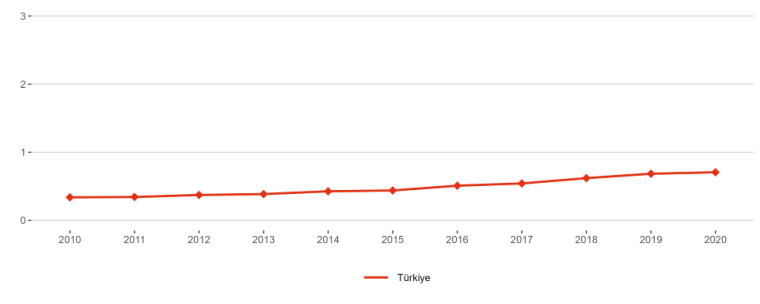
Priority 1: Deepening a truly functioning internal market for knowledge
Sub-priority 1.3: Gender equality, equal opportunities for all and inclusiveness
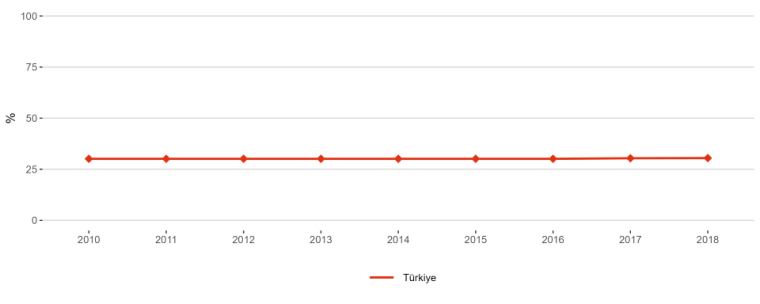
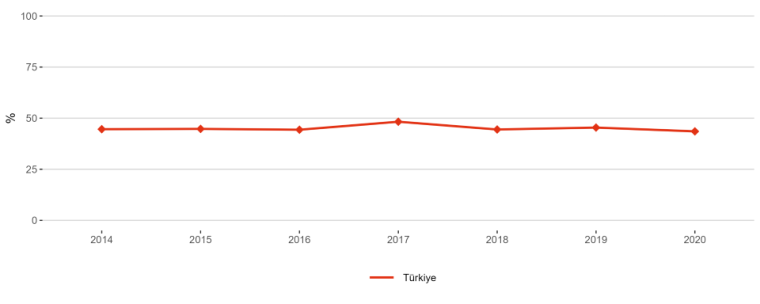


Sub-priority 1.4: Researchers’ careers and mobility and research assessment and reward systems
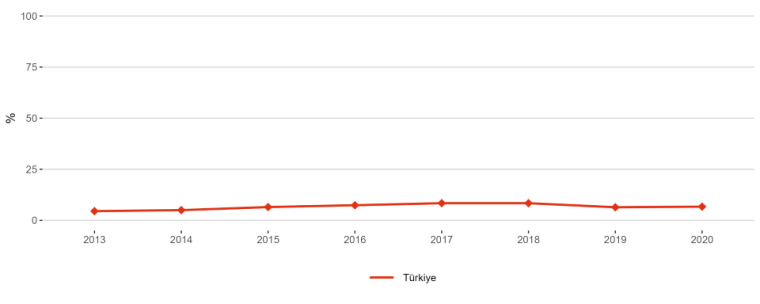
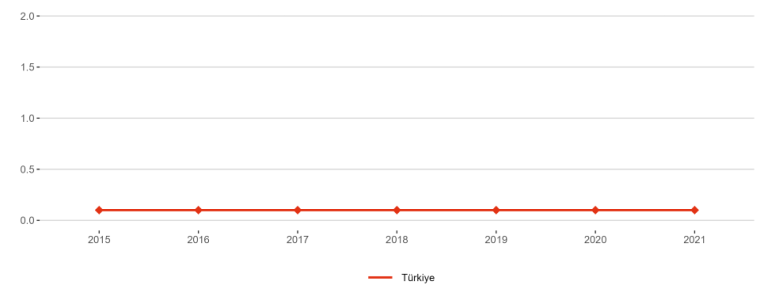

Sub-priority 1.5: Knowledge valorisation
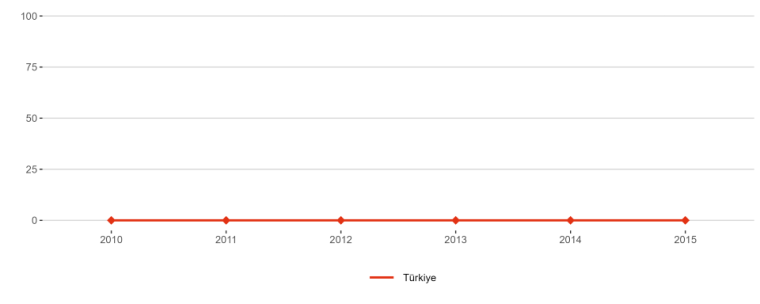


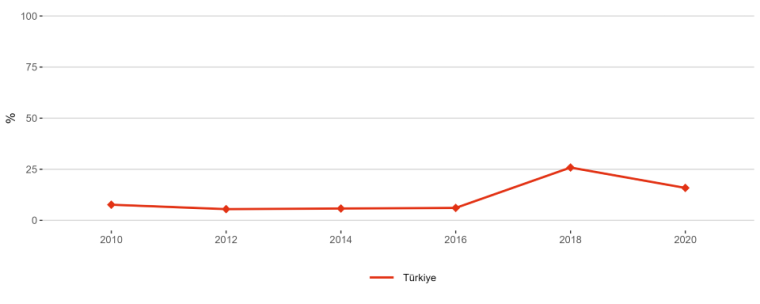
Sub-priority 1.6: Scientific leadership
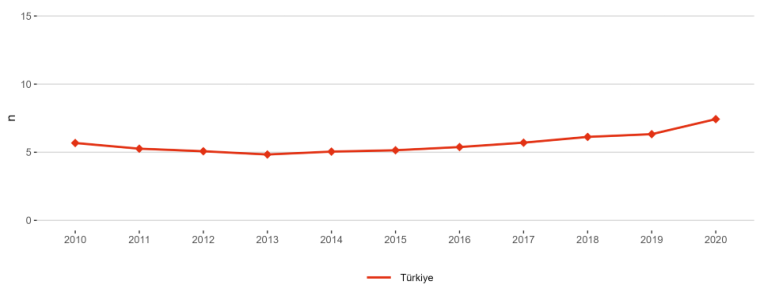
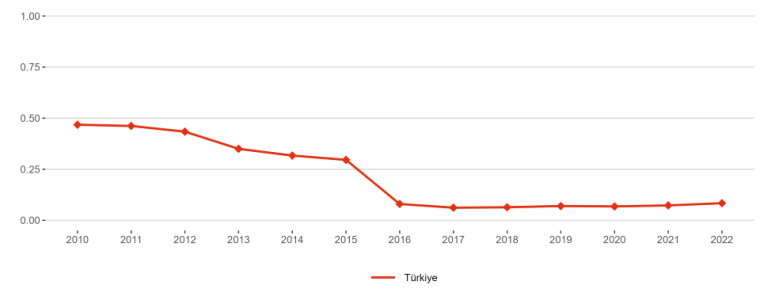
Sub-priority 1.7: Global engagement
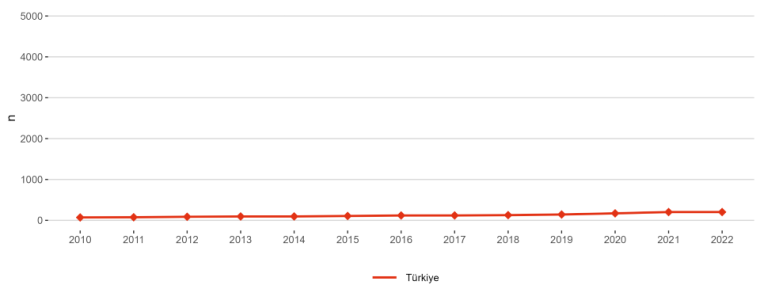
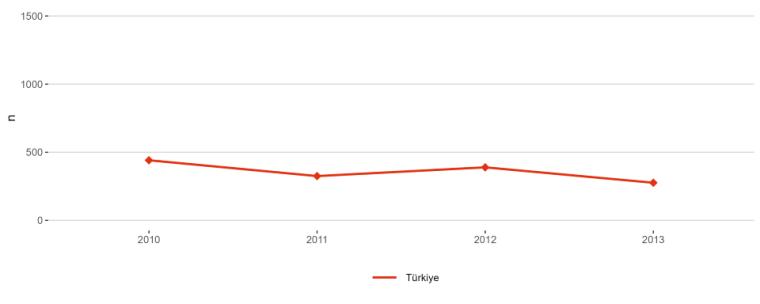
Priority 2: Taking up together the challenges posed by the twin green and digital transition, and increasing society’s participation in the ERA
Sub-priority 2.1: Challenge-based ERA actions
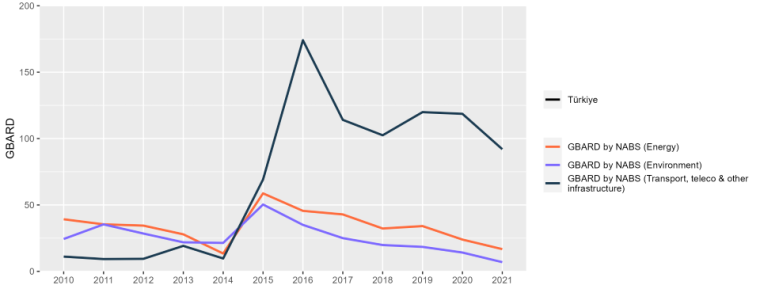

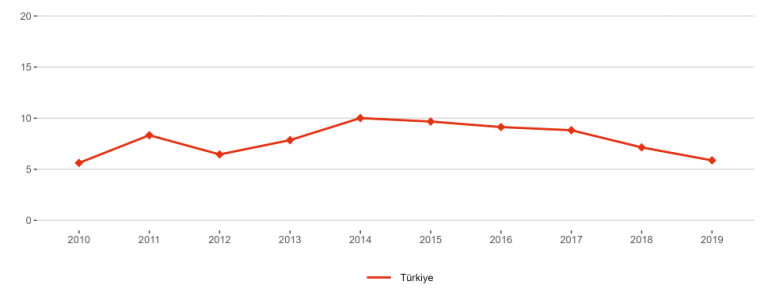
Sub-priority 2.3: Synergies with sectorial policies and industrial policy, in order to boost innovation ecosystems

Sub-priority 2.4: An active citizen and societal engagement in R&I in all its dimensions (Trust in science)

Priority 3: Amplifying access to research and innovation excellence across the Union
Sub-priority 3.1: More investments and reforms in countries and regions with lower R&I performance
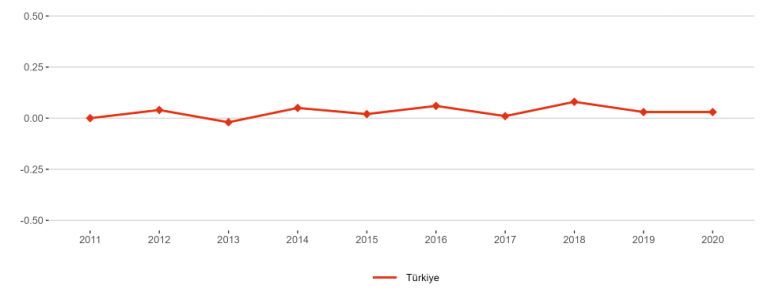
Priority 4: Advancing concerted research and innovation investments and reforms
Sub-priority 4.1: Coordination of R&I investments
